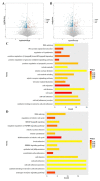An Anti-Cancer Peptide LVTX-8 Inhibits the Proliferation and Migration of Lung Tumor Cells by Regulating Causal Genes' Expression in p53-Related Pathways
- PMID: 32498425
- PMCID: PMC7354478
- DOI: 10.3390/toxins12060367
An Anti-Cancer Peptide LVTX-8 Inhibits the Proliferation and Migration of Lung Tumor Cells by Regulating Causal Genes' Expression in p53-Related Pathways
Abstract
Spider venom has been found to show its anticancer activity in a variety of human malignancies, including lung cancer. In this study, we investigated the anti-cancer peptide toxin LVTX-8, with linear amphipathic alpha-helical conformation, designed and synthesized from the cDNA library of spider Lycosa vittata. Multiple cellular methods, such as CCK-8 assay, flow cytometry, colony formation assay, Transwell invasion and migration assay, were performed to detect peptide-induced cell growth inhibition and anti-metastasis in lung cancer cells. Our results demonstrated that LVTX-8 displayed strong cytotoxicity and anti-metastasis towards lung cancer in vitro. Furthermore, LVTX-8 could suppress the growth and metastasis of lung cancer cells (A549 and H460) in nude mouse models. Transcriptomics, integrated with multiple bioinformatics analysis, suggested that the molecular basis of the LVTX-8-mediated inhibition of cancer cell growth and metastasis manifested in two aspects: Firstly, it could restrain the activity of cancer cell division and migration through the functional pathways, including "p53 hypoxia pathway" and "integrin signaling". Secondly, it could regulate the expression level of apoptotic-related proteins, which may account for programmed apoptosis of cancer cells. Taken together, as an anticancer peptide with high efficiency and acceptable specificity, LVTX-8 may become a potential precursor of a therapeutic agent for lung cancer in the future.
Keywords: LVTX-8; cytotoxicity; migration; nude mouse model; peptide; transcriptomics.
Conflict of interest statement
All authors state that they have no conflicts of interest.
Figures








Similar articles
-
Fatty Acid Modification of the Anticancer Peptide LVTX-9 to Enhance Its Cytotoxicity against Malignant Melanoma Cells.Toxins (Basel). 2021 Dec 4;13(12):867. doi: 10.3390/toxins13120867. Toxins (Basel). 2021. PMID: 34941705 Free PMC article.
-
Comparative Proteomics Identified EXOSC1 as a Target Protein of Anticancer Peptide LVTX-8 in Nasopharyngeal Carcinoma Cells.J Proteome Res. 2024 Jun 7;23(6):2028-2040. doi: 10.1021/acs.jproteome.4c00031. Epub 2024 May 3. J Proteome Res. 2024. PMID: 38700954
-
The preventive effects of hyperoside on lung cancer in vitro by inducing apoptosis and inhibiting proliferation through Caspase-3 and P53 signaling pathway.Biomed Pharmacother. 2016 Oct;83:381-391. doi: 10.1016/j.biopha.2016.06.035. Epub 2016 Jul 14. Biomed Pharmacother. 2016. PMID: 27419887
-
Targeting ion channels for the treatment of lung cancer.Biochim Biophys Acta Rev Cancer. 2021 Dec;1876(2):188629. doi: 10.1016/j.bbcan.2021.188629. Epub 2021 Oct 2. Biochim Biophys Acta Rev Cancer. 2021. PMID: 34610420 Review.
-
Growth inhibitory peptides: a potential novel therapeutic approach to cancer treatment.Eur J Pharmacol. 2025 Jun 5;996:177554. doi: 10.1016/j.ejphar.2025.177554. Epub 2025 Mar 25. Eur J Pharmacol. 2025. PMID: 40147579 Review.
Cited by
-
Therapeutic Peptides for Treatment of Lung Diseases: Infection, Fibrosis, and Cancer.Int J Mol Sci. 2023 May 12;24(10):8642. doi: 10.3390/ijms24108642. Int J Mol Sci. 2023. PMID: 37239989 Free PMC article. Review.
-
LC-AMP-I1, a novel venom-derived antimicrobial peptide from the wolf spider Lycosa coelestis.Antimicrob Agents Chemother. 2025 Jan 31;69(1):e0042424. doi: 10.1128/aac.00424-24. Epub 2024 Dec 2. Antimicrob Agents Chemother. 2025. PMID: 39620694 Free PMC article.
-
Fatty Acid Modification of the Anticancer Peptide LVTX-9 to Enhance Its Cytotoxicity against Malignant Melanoma Cells.Toxins (Basel). 2021 Dec 4;13(12):867. doi: 10.3390/toxins13120867. Toxins (Basel). 2021. PMID: 34941705 Free PMC article.
-
Hepatotoxicity of Pyrrolizidine Alkaloid Compound Intermedine: Comparison with Other Pyrrolizidine Alkaloids and Its Toxicological Mechanism.Toxins (Basel). 2021 Nov 28;13(12):849. doi: 10.3390/toxins13120849. Toxins (Basel). 2021. PMID: 34941687 Free PMC article.
-
Spider-Venom Peptides: Structure, Bioactivity, Strategy, and Research Applications.Molecules. 2023 Dec 20;29(1):35. doi: 10.3390/molecules29010035. Molecules. 2023. PMID: 38202621 Free PMC article. Review.
References
-
- Du Q., Hou X., Wang L., Zhang Y., Xi X., Wang H., Zhou M., Duan J., Wei M., Chen T., et al. AaeAP1 and AaeAP2: Novel Antimicrobial Peptides from the Venom of the Scorpion, Androctonus aeneas: Structural Characterisation, Molecular Cloning of Biosynthetic Precursor-Encoding cDNAs and Engineering of Analogues with Enhanced Antimicrobial and Anticancer Activities. Toxins. 2015;7:219–237. doi: 10.3390/toxins7020219. - DOI - PMC - PubMed
Publication types
MeSH terms
Substances
Grants and funding
- General Program: 21877036/National Nature Sciences Foundation of China/International
- no. 14JJ1018/Science Fund for Distinguished Young Scholars of Hunan Province/International
- 2017KF003/National Development and Reform Commission/International
- 2018TP1017/Science and Technology Planning Project of Hunan Province/International
LinkOut - more resources
Full Text Sources
Medical
Research Materials
Miscellaneous

